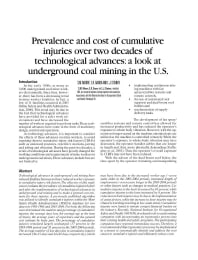Mining Publication: Prevalence and Cost of Cumulative Injuries Over Two Decades of Technological Advances: A Look at Underground Coal Mining in the U.S.
Original creation date: January 2008
Authors: SM Moore, ER Bauer, LJ Steiner
Technological advances in underground coal mining have reduced fatalities but may not have reduced worker exposure to cumulative injury risk factors. The objective of this study was to evaluate the prevalence of cumulative injuries before and after the implementation of technological advances in underground coal mining and to make a general cost estimate for these injuries. A previously published algorithm was utilized to identify cumulative injuries within the Mine Safety Health Administration (MSHA) database for two data sets: 1983-1984 and 2003-2004. For both, the following were determined: the number and percentage of cumulative injuries, the average days lost, the average age at the time of injury, the average years of experience and the general cost estimate by body part. The percentage of cumulative injuries remained largely unchanged (37 percent in the 1983-1984 period and 33 percent in the 2003-2004 period). The average number of lost days due to cumulative injuries increased (36±55 days and 62±82 days, respectively), which may have been due to the increased worker age (~seven years older in the 2003-2004 period), increased length of employment (~seven years longer in the 2003-2004 period) or other factors such as changes in medical practices. Cumulative injuries to the back decreased by 10 percent, while cumulative injuries to the knee increased by 8 percent. The reduction in back injuries may be due to the implementation of assist devices, while the increase in knee injuries may be related to kneeling/crawling in low-seam mines. Cumulative injuries were found to remain a major financial burden on the industry. Recently, National Institute for Occupational Safety and Health (NIOSH) developed tools to assist mining companies with incorporating an ergonomics process into their existing health and safety programs. The participating companies have reported tremendous success. Therefore, it is recommended that ergonomics processes be implemented as a means to systematically identify and address the root causes to cumulative injuries and ultimately reduce costs.
